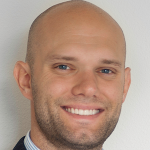Angus Fletcher is a professor of story science at Ohio State’s Project Narrative. His research has been endorsed by renowned psychologists, neuroscientists, and doctors, as well as having received support from major institutions such as the National Science Foundation. In 2023, he was awarded the Commendation Medal by the U.S. Army for his work.
What’s the big idea?
Examining the minds of visionary thinkers and U.S. Army Special Operators has solved many puzzles about how our brains work and how we can help our brains work better. From compiling these case studies, it is clear that there is a path for training your mind to act smart with limited information and outperform computer AI in terms of volatility and uncertainty.
Below, Angus shares five key insights from his new book, Primal Intelligence: You Are Smarter Than You Know. Listen to the audio version—read by Angus himself—below, or in the Next Big Idea App.
1. To activate your intuition, look for exceptions.
For decades, Nobel-prize-winning cognitive scientists and psychologists such as Herbert Simon and Daniel Kahneman have told us that intuition is simply pattern matching. But young children score lower at pattern matching than they do at intuition. How is that possible?
To answer this puzzle, I looked into the minds of Special Operators who possessed unusually high levels of intuition, allowing them to anticipate the future faster than other soldiers on the battlefield.
These Operators had trained their brains to spot what the Army calls exceptional information. Exceptional information is an exception to a previously established rule. It’s a warm-blooded reptile or a rainbow at night. It’s the first person to split from the pack and do the unprecedented. Exceptional information is the opposite of a pattern. It’s the breaking of a pattern.
This is why children score high on intuition. Their brains are focused more on unusual details than on familiar patterns. A four-year-old child can spot up to ten times more exceptional information than the average adult. If you happen to be one of those average adults, don’t worry. You can train your brain to get better at spotting exceptions.
One way to improve your intuition is to travel. Travel immerses your brain in places that break the pattern of your regular life, activating your brain’s power to spot exceptions by putting you in situations where everything is exceptional.
If you don’t have the time or the budget to take a trip, you can get a quick dose of mind-travel from authors like Shakespeare. Shakespeare fills his plays with characters who are exceptions to conventional narrative formulas: Hamlet is an action hero who thinks deeply; Cleopatra is a cold-blooded schemer with a loving heart; Falstaff is an old man who behaves like an adolescent. By giving us characters who break archetypal patterns, Shakespeare opens our minds to the exceptional. In the words of Hamlet: “As a stranger, give it welcome.” Embrace things because they are different.
Because characters like Hamlet activate intuition, Shakespeare’s readers have a history of anticipating the future. Shakespeare reader Nikola Tesla spotted the exception known as the AC motor and used it to usher in modern technology. Shakespeare reader Marie Curie spotted the exception known as radioactivity and used it to usher in modern physics. Shakespeare reader Vincent van Gogh spotted the exception known as aquamarine and used it to usher in our modern color palette. To boost your intuition, don’t think in patterns. Instead, think in exceptions.
2. Optimism comes from the past.
We’re often told by psychologists and business gurus that optimism is more effective than pessimism. But if optimism works better, then why do we keep needing to be reminded? Why hasn’t optimism naturally replaced pessimism, like steel tools naturally replaced stone ones?
Optimism isn’t more effective than pessimism. But, in fact, the psychologists are right. Optimism prompts our brain to take chances that lead to growth, so over time, it does win out over pessimism. But if optimism is biologically stronger than pessimism, why does it seem so fragile? Why do so many of us keep falling back into pessimism?
“If optimism works better, then why do we keep needing to be reminded?”
The answer is: We’re taught optimism wrong. We’re taught that optimism is the belief: This will succeed. But that’s not optimism. It’s magical thinking. Magical thinking preaches the power of a technique known as visualizing success. Visualizing success has been promoted by bestsellers such as Rhonda Burn’s The Secret and Tony Robbins’ Awaken the Giant Within. It was first popularized almost a century ago by Napoleon Hill’s 1937 book, Think and Grow Rich.
In that book, Hill tells us: “When visualizing the money you intend to accumulate, (with closed eyes), see yourself rendering the service, or delivering the merchandise you intend to give in return for this money. This is important!” But no, in fact, this is nonsense. Real optimism isn’t convincing ourselves that this will succeed. Real optimism is much, much stronger. Real optimism is this can succeed.
Why is can stronger than will? If you tell yourself that you will succeed and you don’t, your confidence cracks. But if you tell yourself that you can succeed, then you’ll retain the faith, no matter how many times you fail, as long as you succeed once. That one success is all you need to keep possibility alive, which is why can lives on long after will has shattered.
The way to build optimism isn’t by visualizing all the success you will have in the future. It’s to remember one time you were successful in the past. Unlike magical thinking, which can’t survive reality, this method is so resilient that Special Operators call it antifragile, because no amount of defeat or death can dim it.
Next time you are drifting toward pessimism, remember a time when you succeeded. That memory is stronger than any magic, and with it, you won’t ever need to be reminded to be optimistic again.
3. Your brain is smarter in volatility than AI will ever be.
Computers are more logical than humans. And they can crunch more data, faster. So why is it taking AI so long to replace us? To answer this puzzle, I studied Special Operators who acted smart in situations where AI malfunctioned. Those situations were all different, except for one factor: they were new situations, so there was little to no reliable data about them.
If there was no data about these situations, how were Operators able to outperform random luck? The answer dates back to the Cambrian Explosion, also known as the Big Bang of life, which occurred approximately 500 million years ago. In that prehistoric age, the visual circuits of the archaic brain were evolving the capacity to think in data and symbolic logic. Which is to say, the brain was evolving the ability to think like a computer.
But at that time, the archaic brain was also evolving another complementary mechanism of intelligence. That other intelligence is technically known as narrative cognition. But we can more simply call it: thinking in story.
“Although thinking in story can be a liability in high-data environments, it enables us to act smarter than computers in volatility and uncertainty.”
Story imbued the brain with imagination, wisdom, and other capacities that helped it act intelligently in hazy and fast-changing ecosystems, where relentless competition for resources generated continual innovation, producing new life forms and environments about which there was little or no reliable information.
Although thinking in story can be a liability in high-data environments, it enables us to act smarter than computers in volatility and uncertainty. Which is why, when we studied the brains of those Special Operators who performed well in volatility, we discovered that they were exceptionally good at thinking in story.
4. Art and theater make you smarter at real life.
The more time that children spend in school, the more anxious and angry they get. What’s the problem? Is it too much technology use? Or are we being too nice—and overcoddling our kids?
No. Neither technology nor overcoddling is the root cause of student anger and anxiety. To find the real culprit, let’s start with the anger and anxiety. These emotions are physiological indicators of a threat response.
The logical way to eliminate this threat response is to remove the threat. Schools have tried this by focusing on creating safe spaces and excluding things from classrooms that might cause children to feel anxious or angry. This solution is logical, but it’s not biological. In the real world, what stops the brain’s threat response isn’t an outside force that removes the threat. It’s an inside force, within the brain, that comes up with a plan for dealing with the threat.
You can see this in Special Operators. Special Operators don’t spend their lives trying to avoid threats. They spend their lives running toward threats. Yet those threats don’t make Operators anxious or angry. Why? Because as rapidly as the world can create a threat, the Operators’ brains are able to imagine a plan for dealing with it. They don’t feel anxiety or anger because they have trained their imaginations to evolve at the speed of life.
To do that training, Operators go through special classes at the John F. Kennedy Special Warfare School, where they exercise their imagination by engaging in role-playing exercises. Outside of Special Operations, in kindergarten through college classrooms, role-playing can be taught by doing theater, literature, history, and other arts and humanities activities that encourage students to imagine themselves as other people in other parts of the world.
“They don’t feel anxiety or anger because they have trained their imaginations to evolve at the speed of life.”
In schools, these role-playing activities are increasingly being replaced by technology, which delivers art and history to students on computers and digital screens. But technology is less effective at growing children’s imagination than books and stages, because by having screens automate the physical work of staging the action, it doesn’t exercise the imagination muscles of the brain.
Although technology and too much coddling can worsen student anger and anxiety, neither is the root cause of the problem. The root cause is that we’re not giving students enough of the history books and theater roles that strengthen their brains’ ability to imagine plans, empowering them to live like Special Operators and deal with threats themselves.
5. Leaders don’t think in probabilities.
Businesses spend approximately $16 billion annually on leadership training. While that training gets good marks for producing managers, it gets poor marks for producing leaders. What’s the training missing?
The training is missing the brain’s premotor cortex. It’s focused instead on the inferior parietal lobe. To translate that out of neuroscience, current business training is focused on teaching executives to think in probability. So, it isn’t expanding their ability to think in possibility.
Possibility is often misunderstood as a low-end probability, say, for example, ten percent. But possibility is not a kind of probability. It involves a fundamentally different mental process. Probability is calculated from events that have happened before. Meanwhile, possibility is an event that has never happened—but could happen, because it doesn’t contradict the rules of life. Probability is the method used in statistics and computer AI. Possibility is the method of story and imagination.
As an example of the difference between probability and possibility, there’s the airplane. In 1902, the British statistician Lord Kelvin declared that there would never be an airplane. But a year later, the Wright Brothers built one and it flew. Was Lord Kelvin a fool? No. He was one of the best mathematicians of his time. But he was thinking in probability. And the probability of an airplane in 1902 was zero, because it had never happened before.
“Possibility is the method of story and imagination.”
The Wright Brothers saw, however, that the airplane didn’t violate the laws of physics—making it possible. As a result, they were able to engage in original thinking, enterprise, and initiative. These are the key mental qualities of entrepreneurs, and of leaders in general.
If you want to train leaders—or become a leader yourself—don’t invest in training that emphasizes probability. Steer clear of scientific management and other fields heavy in math, statistics, and quantitative approaches. Instead, do like the Wright Brothers and boost your practical imagination by feeding your brain with realistic tales of make-believe.
The Wright brothers often skipped school to stay home reading the creative novels of Charles Dickens, Mark Twain, and Washington Irving. If those literary classics don’t match your taste, do like Special Operators and read novels set in the near future or in a culture that’s different from yours. These stories will stimulate your brain’s premotor cortex, expanding your sense of possibility and helping your leadership abilities take flight.
Enjoy our full library of Book Bites—read by the authors!—in the Next Big Idea App:










